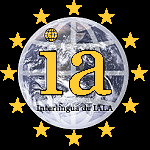Interlingua facts for kids
Quick facts for kids Interlingua |
||||
|---|---|---|---|---|

Logo
|
||||
| Pronunciation | IA: | |||
| Created by | International Auxiliary Language Association | |||
| Date | 1951 | |||
| Setting and usage | Scientific registration of international vocabulary; international auxiliary language | |||
| Users | 1,500 (2000) | |||
| Purpose |
International auxiliary language
|
|||
| Writing system | Latin script | |||
| Sources | Source languages: English, French, Italian, Portuguese, and Spanish, with reference to some other control languages (mainly German and Russian). | |||
| Official status | ||||
| Regulated by | No regulating body | |||
|
||||
Interlingua is a special language that was created by people. It uses words that are common in many languages from Western Europe. A group called the IALA worked on it for over 20 years. They finished and published the first dictionary in 1951.
Interlingua was made using words from English, French, Spanish, Portuguese, and Italian. The name Interlingua means "between languages." This is because "inter" means "between" and "lingua" means "language." The goal was to help people from different countries talk to each other easily.
Because Interlingua was designed to be simple, it is often easier to learn than natural languages. As of As of 2000[update], about 1,500 people knew Interlingua. People who speak it say that millions can understand it without even learning it first. This means they can read texts or listen to it and get the main idea.
Contents
What is a Constructed Language?
A constructed language is a language that someone created on purpose. It is not a language that developed naturally over time, like English or Spanish. Interlingua is one example of a constructed language.
There are other constructed languages with many speakers. Two well-known ones are Esperanto and Ido. These were made before Interlingua. Some people think Esperanto and Ido are easy because they have very few exceptions. This means their rules are very regular.
However, other people think Interlingua is easier. This is because its creators chose words that are already familiar. They picked words that people who know English, French, Spanish, Portuguese, or Italian would easily recognize. They also looked at languages like Occitan and Romanian. These languages came from Latin, which was spoken in Rome a long time ago.
Some people who use Interlingua even say it is like a new, simpler version of Latin. They call it "modernized" Latin.
How Interlingua Sounds
Here is an example of text written in Interlingua. You might find that you can understand some of the words.
Lingua natural e musical
de parolas international
e un grammatica minimal.
Comprensibile facilemente
per personas intelligente.
Le medio de communication
adequate pro le solution
del confusion de Babylon.
The Lord's Prayer in Interlingua
This table shows a famous prayer, "The Lord's Prayer," in Interlingua. You can compare it to the Basic English version to see how similar the words are.
| Interlingua | Basic English |
|---|---|
| Nostre Patre, qui es in le celos, que tu nomine sia sanctificate; que tu regno veni que tu voluntate sia facite super le terra como etiam in le celo. Da nos hodie nostre pan quotidian, e pardona a nos nostre debitas como nos pardona a nostre debitores, e non duce nos in tentation, sed libera nos del mal. |
Our father in heaven, may your name be kept holy. Let your kingdom come. Let your pleasure be done, as in heaven, so on earth. Give us this day bread for our needs. And make us free of our debts, as we have made free those who are in debt to us. And let us not be put to the test, but keep us safe from the Evil One. |
Related Pages
Images for kids
See also
 In Spanish: Interlingua para niños
In Spanish: Interlingua para niños



